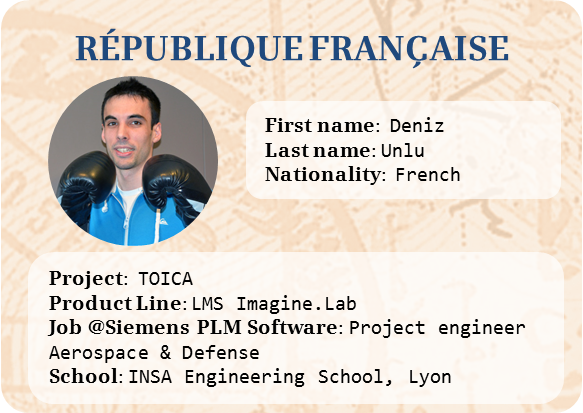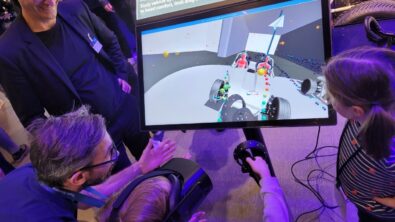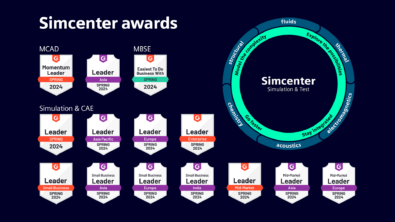Researcher of the month: Deniz Unlu

What you probably don’t know is that Siemens PLM Software is involved in a variety of international research programs around the globe – everything from safer, quieter and more efficient airplanes to electronic vehicle research. It is something we’ve been doing for years and it is a great way to incubate new concepts and ideas that later transform into market-ready products. It is an amazing place for young researchers and post-grad students to really push their limits in a business environment.
 How did you end up at Siemens?
How did you end up at Siemens?
I had my first job at ALSTOM GRID as an R&D engineer where I discovered LMS Imagine.Lab Amesim software from product lifecycle management (PLM) specialist Siemens PLM Software. Following this experience, I applied to Siemens PLM Software and I got the job I wanted in the R&D aerospace team in 2013. Then, I started to work on the TOICA project.
 What is your project about?
What is your project about?
TOICA means Thermal Overall Integrated Conception of Aircraft. In the aircraft design process, thermal studies usually happen at the end. The purpose of this project is to highlight thermal issues in a plane and integrate them early in the design process.
Learn more about Simcenter Aerospace Systems Solutions.
 The actual trend towards more electric aircraft (MEA) is spreading and we are seeing more electricity in aircraft systems. However, all this electricity generates heat, so thermal systems have to be improved. There is a need to integrate thermal constraints in the first design stage and to choose accordingly between different architectures to manage these thermal issues. With TOICA, my goal is to develop tools and technology to manage this challenge.
The actual trend towards more electric aircraft (MEA) is spreading and we are seeing more electricity in aircraft systems. However, all this electricity generates heat, so thermal systems have to be improved. There is a need to integrate thermal constraints in the first design stage and to choose accordingly between different architectures to manage these thermal issues. With TOICA, my goal is to develop tools and technology to manage this challenge.
Different people work in the project: aircraft manufacturers, universities and suppliers. Each partner is engaged in several tasks covering different aspects of the project (collaborative work, modelling and simulation capabilities, thermal studies, plateau and trade-offs, communication). Partners are working together, bringing their expertise to fulfill the project objectives. You can also go on the public website if you want more information: http://www.toica-fp7.eu/
 Why did you choose this area?
Why did you choose this area?
I really like thermal issues; they are present in a broad framework from the whole plane to the small equipment. Moreover, the thermal area is related to electric, pneumatic and hydraulic models, so I can cover a wide range of domains and learn a lot about aeronautics!
 What is the craziest thing you have ever done as an engineer?
What is the craziest thing you have ever done as an engineer?
We are not allowed to do really crazy things!
When I was in engineering school, I worked on a project to couple technology with art. I wanted to create a system of light on a juggling material to create a show with amazing light.
 What is the best thing about your research project?
What is the best thing about your research project?
According to me, the best thing is the diversity of activities and partners. It is an excellent way to stay in contact with our customers. Our relationship is different than the classical one as we all work together towards the same goal.
 What is the worst thing?
What is the worst thing?
When I began, the most challenging part was to understand the global organization of the project and manage to work efficiently with various partners. A lot of tasks are in the project; I had to understand each one of them as well as the different relationships between the partners. We are around 150 people working on TOICA.
 Do you think your work will really make a difference?
Do you think your work will really make a difference?
TOICA responds to a real need, the purpose is to reduce the cost of energy, which is an actual challenge in the field. It is a research project: we share knowledge and we develop technology, which has value on its own. The industrialization of the capabilities developed in the frame of the project ideally happens during or right after the project’s end, but this strongly depends on the maturity of these capabilities.

25 years from now, there will be…?
TOICA will end in September. However, our work will influence the future aircraft’s configuration. So, 25 years from now the aircraft configuration will be different and the electric part will be more important in every engine.
If you weren’t an engineer, what would you be?
I would be a blacksmith! I really enjoy working with metal; the know-how of these artisans always impressed me.
 Will engineering change the world?
Will engineering change the world?
It already happened several time in the past! Engineering already changed the world through all types of innovation like the cellphone or Internet. It will probably continue to do this and we have to imagine which form it will take in the future.


